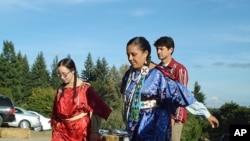The rate of natural increase of the U.S. population - births minus deaths - is about one percent per year. However, the growth rates of American Indian tribes over the past decade has been two or three times as high, depending on the tribe.
Enrolling in a tribe is not like immigrating to another country or joining a social club. Tribal citizenship is based on blood lines.
The U.S. government recognizes 566 American Indian and Alaska Native tribes and bands within its borders.
In some respects, they're nations within a nation. Native American tribes can make their own laws on their reservations. Tribal governments have the sole authority to determine who can be a member of the tribe.
Rising prosperity from casinos and other businesses is luring Native Americans back into the fold. However, fast growth has strained the fabric of some tribes, while others wish they had more members.
The swelling membership of the Tulalip Tribes, based near Everett, Washington, for example, is a point of pride for tribal member and state representative John McCoy, who believes improved health care and an above-average birth rate are at play.
"We're living longer. Our babies are surviving birth," says McCoy, adding that more jobs on reservations, led by tribal gaming, is another reason for the growth. "So we have our peoples coming back from other states. They're coming home because there is an economy."
At Tulalip, that adds up to a 22 percent growth rate over the past decade. Other tribes around the country have grown even faster.
And some of those have felt the need to tighten enrollment criteria to control burgeoning growth. California has even witnessed a spate of bitter purges by some tribal governments. The biggest motive appears to be financial.
For example, the Puyallup Tribe in western Washington state currently pays each enrolled man, woman and child $2000 per month in profit sharing. Tribal members voted to clamp down on new enrollments in 2005.
Like the Puyallups, the Grand Ronde Tribe in western Oregon operates a successful casino. Grand Ronde tribal members have revisited their enrollment standards three times since 1999.
The most recent election was a couple months ago. Tribal members voted to keep strict enrollment standards in place. Among other things, new members need to have a parent on the tribal membership roll at the time of birth. Before the vote, Dee Edwards posted a tearful YouTube video about how technicalities in the rules split her family and excluded her grandchildren.
Former tribal councilmember Andy Jenness taped that video and favors a looser standard that wouldn't split families.
"The amount of growth that is acceptable to me is that of natural birth and the tribe growing at the natural rate, whatever that is," Jenness says. "If that means I have less in my per capita check, so be it."
But other members wrote letters and posted online to warn against opening the "floodgates" of tribal membership. Over the years, people have complained about "tribal jumpers." These are Native Americans whose heritage includes connections to multiple tribes.
"Jumping" refers to relinquishing citizenship in one tribe to switch to a richer one. If too many people do that, it can dilute the profit-sharing checks or strain services in the tribe everyone wants to get into.
At the other end of the spectrum are tribes whose enrollments are stagnating, including for example the Colville Confederated Tribes in northeast Washington.
Tribal councilmember Ricky Gabriel has proposed a referendum to relax the blood requirement in the tribal constitution so more children of mixed marriages can enroll.
"I've had a lot of very positive [reactions]," he says. "The elders are extremely happy about this. They're pushing hard. They're seeing their grandchildren not be able to be enrolled."
Enrollment in the tribe currently requires a minimum of one-quarter Colville blood. But when you have intermarriage, that bloodline is diluted. It takes just a couple of generations of intermarriage to put the children at risk of being disqualified from membership.
Then the tribal population withers. The proposed referendum would change the rules to count any Indian blood toward the minimum.
Dozens of tribes around the country including the Tulalips and Puyallups have gotten rid of blood quantum requirements altogether. They now base membership on direct descent from tribal members on the historic rolls.









